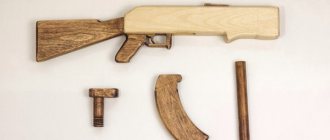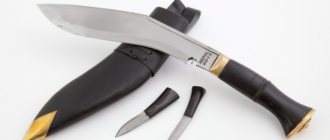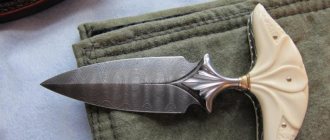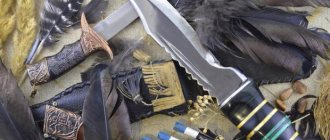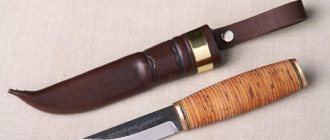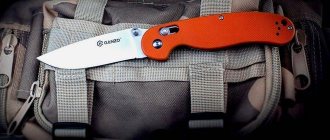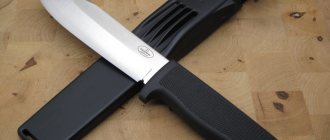Let's find out what is possible and what is not possible when carrying and storing knives from the point of view of Russian legislation, especially since in recent years there have been quite a lot of changes in this area.
Simplified in Russia, knives are divided into two categories, these are:
- knives that are not edged weapons;
- knives that are edged weapons.
In the photo, the knives are either edged weapons or not.
Almost all knives that we use in everyday life fall into the category of knives that are not edged weapons.
These are kitchen, table, and folding knives. This also includes fixed blade knives that are used by tourists and hunters for various purposes. But these same knives can also fall into the category of edged weapons.
The category of knives, which is a bladed weapon, is a separate category that is quite difficult for an ordinary person to purchase, and impossible in a regular store.
You can legally purchase a knife that is a bladed weapon in the Russian Federation in the following way:
- go to military service in the army or some state paramilitary structure;
- become a hunter, or simply issue a hunting license and obtain permission to store and carry smooth-bore or rifled hunting weapons;
- be a representative of national minorities who are allowed to carry bladed weapons with their national costume;
- become a collector and obtain a permit to store collectible edged weapons.
Theoretically, you can make a knife that is a bladed weapon yourself or order it from some blacksmith, but then you will fall under Articles 222 and 223 of the Criminal Code of the Russian Federation.
How to understand that a knife is a bladed weapon

In the photo, the large knife at the top is not a bladed weapon. At the same time, a small knife from Ka-Bar is a bladed weapon.
Unfortunately, without an examination or a certificate of compliance with any GOST, it is impossible to understand whether a knife is a bladed weapon or not.
In Russia there is a document that describes all the requirements for edged weapons:
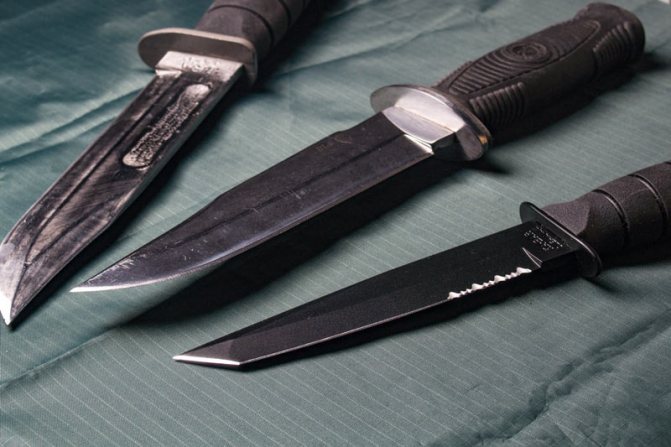
Steel arms
Quote from this GOST:
SIGNS ON THE BASIS OF WHICH PRODUCTS ARE CLASSIFIED AS EDGE WEAPONS
B.1 The presence of structural elements in the product with a tip and (or) one (two) blade (blades) and (or) concentrated mass and a hard surface.
B.2 Compliance of the weight and overall dimensions of the product with the physical capabilities of a person, which allows them to wear these products and operate them manually.
B.3 Sufficient human muscular energy to effectively defeat a living target with a single use of the product.
B.4 Lack of a direct and convenient way to use the product to perform household or industrial work.
B.5 The presence of structural elements that facilitate the use of the product to hit a target and interfere with the performance of household or industrial work.
B.6 The product has strength and reliability that is excessive for its use as a tool when performing household work.
As we can see, according to this GOST, theoretically any knife can be classified as a bladed weapon, therefore in (Article 1) there is the following paragraph:
- Weapons do not include products certified as household and industrial products, sports equipment that is structurally similar to weapons (hereinafter referred to as products structurally similar to weapons).
Accordingly, knives sold in the Russian Federation must have certificates that are provided by the seller or manufacturer when selling the knife. If he doesn’t have them, then at a minimum he violates the rules of trade and the Law on Consumer Rights, and at a maximum 222 of the Criminal Code of the Russian Federation if his knife turns out to be a weapon.
We recommend: How to choose and how to tie fluorocarbon fishing line?
does not classify household products as weapons, which include most knives, and they are freely sold in our stores.
These products and knives are classified by the following GOSTs (for knives only, we do not consider other products in this article):
and others (the list is quite large, for example, medical, vaccination and others, most citizens rarely encounter these, so we do not provide links to GOSTs for them; if desired, they can be easily found on legal portals).
Accordingly, if your knife falls under one of these GOSTs, then it is not a bladed weapon.
Separately, in the Weapons Law there is such a term as products structurally similar to weapons, which do not relate to edged weapons. Numerous naval dirks and bayonet knives from a Kalashnikov assault rifle are now sold under this formulation.
How not to accidentally buy edged weapons:
Strange as it may sound, in the Russian Federation you can accidentally buy a weapon, namely a cold weapon, while neither the seller nor the buyer may have any idea what they are actually buying or selling, but this does not exempt either one from responsibility, so it is necessary know the following:
- When buying a knife in a store, if you have doubts about it, ask for a certificate for the knife from the seller, which states which class and GOST it belongs to. Although the likelihood of buying a bladed weapon in an ordinary non-weapons store is practically zero;
- Do not buy knives from hand, or at bargain shops, if there is no certificate, the same applies to homemade knives, first look at the GOST standards for edged weapons;
- Theoretically, it is impossible to buy edged weapons in a regular store, since only specialized stores with the appropriate license issued by the Russian Guard can sell weapons, and they cannot sell them without you having a license to carry and store hunting weapons and a hunting license, or other permits that allow you to store and purchase edged weapons.
In a situation where you have a knife, but there is no certificate for it, you will have to independently study the GOSTs above and find out which class it belongs to.
Advice:
If your knife is not a combat knife (for example, attached to a weapon as a bayonet, a naval dagger), then you can analyze this one. If your knife does not fall under this GOST, then there is no need to worry too much, most likely it is not a bladed weapon.
Please note that some folding knives fall into the bladed weapons category.
The Weapons Law (Article 6) prohibits the circulation of bladed weapons and knives, the blades and blades of which are either automatically removed from the handle when a button or lever is pressed and fixed by them, or extended due to gravity or accelerated movement and automatically fixed, depending on the length of the blade and blades over 90 mm.
There are no GOST standards for combat knives in the public domain, if they exist at all; foreign-made combat knives are certified as hunting bladed weapons.
Peculiarities of carrying knives on the territory of the Russian Federation
On the territory of Russia, you can carry knives anywhere and any kind, with the exception of knives related to edged weapons. How you can carry edged weapons is described in the Weapons Law.
You can only carry edged weapons with a Cossack uniform and national costumes, but you must also have the appropriate documents for this. Hunting edged weapons, if you have permits, can only be carried in hunting grounds; in other cases, only their transportation is permitted.
Separate acts and orders may prohibit the carrying of knives (piercing and cutting objects) in places where any organized events are held or at sensitive facilities.
If you have a knife while attending such an event, the organizers have the right not to let you into it or ask you to leave this place, or hand over the knife for safekeeping.
You do not have the right to confiscate or take away your property, which is a knife.
If you were stopped by a police officer or the National Guard and decided legally search your belongings or search your property, and found a knife on you, then several options are possible:
- he can confiscate it before the end of the investigative actions, and then return it; if he does not return it, then this is an official crime for which he will have to bear responsibility;
- if he believes that this is a bladed weapon, he must send it for examination, which will decide whether it is one or not.
If the examination recognizes your knife as a bladed weapon, and you do not have permits to carry it, then you will face punishment under Article Part 4. Violation of the rules for storing, carrying or destroying weapons and ammunition by citizens.
A fine of 500 to 2000 rubles; if you have permission to carry and store weapons, then temporary deprivation of this right is possible.
Please note that the search, examination and seizure must be carried out within the framework of current legislation and recorded in appropriate protocols , which can subsequently be appealed. Do not forget about Article 51 of the Constitution and the right to the assistance of a lawyer or defender. payment for the services of a defender or lawyer through the court from the organization that carried out unlawful actions against you, if they were truly unlawful.

Two inconspicuous and small knives on top are edged weapons. The second knife from the top in some countries is considered a military weapon and is used in the armed forces. At the same time, large and no less durable folding knives from below are not edged weapons and they can be carried freely throughout the country.
Carrying hunting knives is only possible in hunting areas if you have a permit for a hunting weapon and a hunting license. In other places, if you have these documents, you can transport it.
Important: violation of the rules for transporting and carrying hunting knives is punishable under Article Part 4, which, in addition to a fine, provides for temporary deprivation of the right to keep and carry weapons, so be careful if you decide to take a hunting knife fishing and decide to hang it on your belt instead of leaving it in a sheath in a backpack.
There is no need to carry or keep any certificates stating that a knife is not a bladed weapon, no law forces you to do this, you are not obliged to present these papers to police officers or other authorities, and they are not documents for them. If a knife was confiscated from you on suspicion of being a bladed weapon, then the document will be the result of a forensic examination, and not your certificate.
Knives on public transport
Traveling with a knife that is not a bladed weapon in the subway, trains and other types of transport, with the exception of an airplane, is permitted freely.
If you are harassed by security officers (usually in the subway or at train stations), calmly write a complaint against them to this organization, to the organization that issued them a license for security activities and to the prosecutor's office for exceeding their official duties and illegally restricting your rights.
If the knife is a bladed weapon, you only have the right to transport it in any type of public transport if you have the appropriate permit; for hunting knives, this is a hunting ticket and a permit to store and carry firearms.
In this case, you are required to present these documents only to the police officer, and not to security officers.
Do not forget about your obligation to prevent access to weapons by unauthorized persons; this also applies to bladed weapons, so if you let them go on the X-ray tape without being seen, you could theoretically incur administrative liability.
To avoid this situation, ask to invite a police officer, show him your permits and go freely to the station or metro.
Knives on the plane
When transporting bladed weapons by plane, it is better to first call the airport security service and find out how it is easier for you to transport your hunting knife. Most likely, you will be asked to check it either as luggage or to security, who will load it onto the plane, and you will receive it upon arrival at your destination.
When handing over or transporting bladed weapons in your luggage, do not forget that you are losing control over them and giving access to the weapon to unauthorized persons, for which you will face liability. It is better to hand it over to airport security and receive it from them upon arrival at your destination.
Regular knives are carried in checked luggage. You will not be allowed on board a plane with a knife, and this is legal.
ORIENTATION OF THE KNIFE IN THE SHEATH / GRIP OF THE KNIFE
You should also take into account the orientation of the knife in the sheath, or more precisely, take into account which direction the blade is directed. This directly determines how the knife will be oriented in the hand after it is removed, and whether it will need to be unfolded.
If, when holding the knife with a direct grip, the knife is oriented inward, that is, the blade is directed towards the thumb, and the butt towards the index finger, this position is convenient for cutting with a “toward” movement. It’s so convenient to plane wood, cut ropes, cut a sentry’s throat if you manage to approach him from behind unnoticed, deliver “rip-up” blows from the bottom up, and peel potatoes.
If the knife occupies a position with the blade outward, i.e., with the blade towards the index finger, the butt towards the thumb, then in this position it is convenient to perform most of the work, moving away from you. In addition, this position is familiar to everyone since childhood; this is how the knife is held every day, cutting bread and sausage into sandwiches.
With a reverse grip, when using a knife for self-defense, the knife is usually held with the blade facing outward. This allows, while hiding the knife behind the hand for the time being, when approaching a critical distance, inflicting a sudden powerful cut. If you need a strong “ripping” cut, for example, when ripping open a very dense bag, with a not very sharp knife, it is more logical to hold the knife with the blade inward, since, having stuck the knife in, you will need to pull it towards you. This allows you to apply more force to the knife than when pushing it away.
